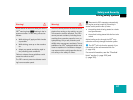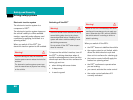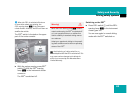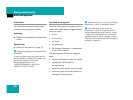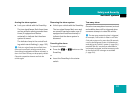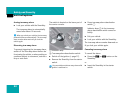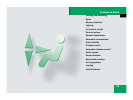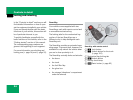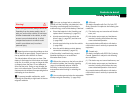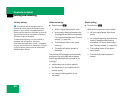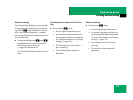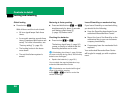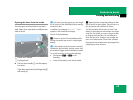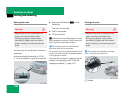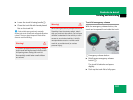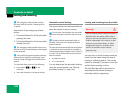
95
Controls in detail
Locking and unlocking
Warning! G
When leaving the vehicle, always remove the
SmartKey from the starter switch, take it
with you, and lock the vehicle. Do not leave
children unattended in the vehicle, or with
access to an unlocked vehicle. A child’s
unsupervised access to a vehicle could
result in an accident and/or serious
personal injury.
!
Opening a door causes the windows on that
side of the car to open slightly. They will return to
the up position when the door is closed.
The side windows will not open or close if the
battery is discharged or the windows are imped-
ed by ice. As a result, you may no longer be able
to properly close the door. Do not attempt to
force the door shut. Doing so may damage the
door or the side window. Correct the condition
that prevents the windows from operating before
attempting to close the door.
!
To prevent possible malfunction, avoid
exposing the SmartKey to high levels of electro-
magnetic radiation.
!
If you can no longer lock or unlock the
vehicle with the SmartKey, the batteries in the
SmartKey are discharged, the SmartKey is
malfunctioning, or the vehicle battery is drained.
ț Check the batteries in the SmartKey and
replace them if necessary (
୴ page 391).
ț Use the mechanical key to unlock the
driver’s door (
୴ page 387) and the trunk
(
୴ page 388).
ț Use the mechanical key to lock the vehicle
(
୴ page 388).
ț Have the vehicle battery and the battery
connections checked (
୴ page 415).
If the SmartKey is malfunctioning, contact
Roadside Assistance or an authorized
Mercedes-Benz Center.
i
Without the antenna on the left rear side of
the vehicle installed, the SmartKey signaling
range is considerably reduced. Hold the
SmartKey in close proximity towards the
antenna base when locking or unlocking the
vehicle.
i
You can also open and close the retractable
hardtop using the SmartKey* (
୴ page 244).
i
USA only:
This device complies with Part 15 of the FCC
Rules. Operation is subject to the following two
conditions:
(1) This device may not cause harmful interfer-
ence, and
(2) this device must accept any interference
received, including interference that may
cause undesired operation.
Any unauthorized modification to this device
could void the user’s authority to operate the
equipment.
i
Canada only:
This device complies with RSS-210 of Industry
Canada. Operation is subject to the following
two conditions:
(1) This device may not cause interference, and
(2) this device must accept any interference
received, including interference that may
cause undesired operation of the device.
Any unauthorized modification to this device
could void the user’s authority to operate the
equipment.



